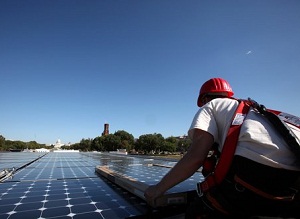Solar energy news recap
 In preparation of today, either the most romantic or saddest day of the year, the world of solar energy kept it sexy last week, with news coming from all over the country, as if to say: I'm solar energy; will you be my Valentine?
In preparation of today, either the most romantic or saddest day of the year, the world of solar energy kept it sexy last week, with news coming from all over the country, as if to say: I'm solar energy; will you be my Valentine?
A new survey last week found that solar is the most favored form of clean energy in the United States. A full 79 percent of respondents saw solar favorably. It was considered more favorable than wind power, which respondents viewed 75 percent favorably.
A Washington state utility, Inland Power and Light Co., also found favorable results for solar over wind. The utility tested a wind turbine and a photovoltaic array of similar sizes and costs and found that the photovoltaic array produced much more power than the wind turbine did.
It appears that Congress likes solar too. Both houses of Congress sent letters to the Secretaries of Interior and Energy requesting the Solar Decathlon be held on the National Mall, where it previously had been held. However, as of the end of last week the event remained homeless.
Even though the location of the Solar Decathlon, one of the most public solar events, is still up in the air, the Department of Energy announced its new SunShot Initiative, a $27-million effort to reduce the cost of solar by 75 percent.
The energy department also co-hosted a meeting with the Bureau of Land Management in California to get comment on the Draft Federal Solar Development Programmatic EIS (Environmental Impact Statement). The energy department will use the EIS to help speed the process through which large-scale solar projects are developed. Over 100 people attended the event, including environmentalists opposed to large-scale solar projects being developed in California.
They’re not the only people that have thrown some roadblocks in front of solar developers.
CURE, the California Unions for Reliable Energy, sued the Bureau of Land Management over permitting Genesis Solar Energy Project. But at least two other California unions have criticized CURE for the action, saying it is just one instance where CURE has used legal tactics to block renewable energy development until the developer signs a contract with CURE’s parent unions.
The Colorado Solar Energy Industries Association (COSEIA) annual Solar Power Colorado conference is too big for its britches. The meeting, a solar industry event, sold out a week in advance, surpassing its previous attendance record by nearly 30 percent. Among other things at the conference, solar industry insiders discussed legislation proposed in Colorado that would undo previous solar legislative victories.
Last week, Intel Corp., one of the largest computer processor makers in the world, said it was upping the amount of renewable energy credits it voluntarily purchases to approximately 85 percent of its total energy use. In 2011, it agreed to buy 2.5 billion kilowatt hours of renewable energy credits. The company also announced last week that it has installed a total of 3 megawatts of solar at nine of its facilities.
American Modular Systems cofounder Tony Sarich applied his prefabrication work, creating Gen7 high-efficiency green classrooms, to build a prefabricated, solar powered winery at the site of his future home in California. It is the first LEED winery in the region.
CPS Energy, a San Antonio, Texas, utility issued a request for proposals for a 50-megawatt solar installation. But as part of the proposal it wants the winning company to build a facility in San Antonio.
Image courtesy ofd



